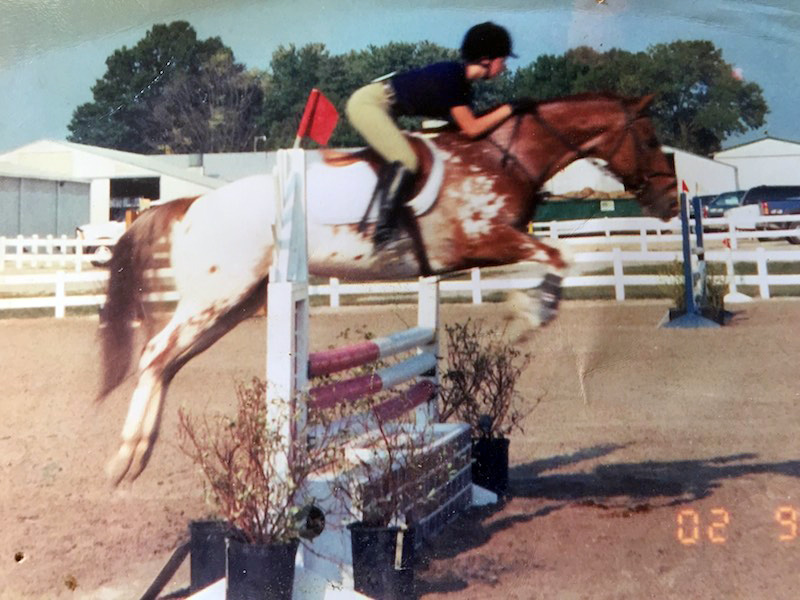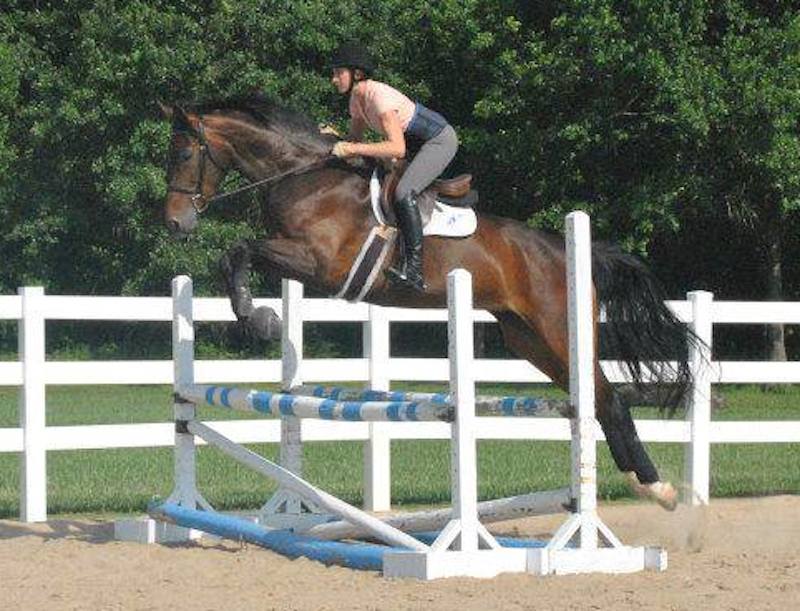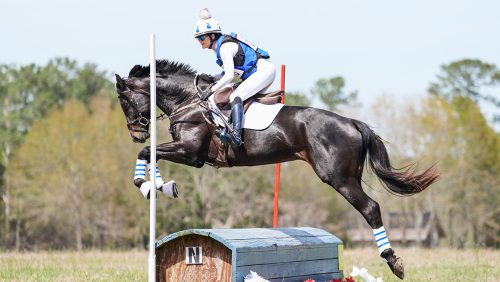Amateur rider Jennifer Baas sent us this letter in response to COTH’s transcription of the WiSP Sports podcast about the state of show jumping with Katie Prudent, “A Conversation With Katie Prudent: U.S. Show Jumping Has Become Dummied Down.”
Dear Ms. Prudent,
My name is Jennifer (Bayer) Baas, and I am an amateur. I am not fearful, I am not weak, and though not overly talented, I’m not talentless.
As a teen, I had been desperate to ride in the big eq with the goal of proceeding up the jumper ranks. But at that time (early 2000s), getting into a show barn and riding in the big classes was always out of my reach. I had a very cute but not consistent Thoroughbred who would not have been truly competitive in anything but the jumpers.
I remember the day I heard that leasing a horse just for finals cost somewhere around $25,000, and I was crushed because I finally realized that riding at the level I wanted to simply wasn’t possible for someone with my limited financial means.
When you talk about needing to have riders who have had a background in hard work, horsemanship, and the experience of sitting on a ton of different horses, I want to wave my hands and say “I was here! I’ve been here all along! And so have many of my dear friends! You just never saw us!”

Showing my first horse, Rambo, at an A show in 2006. Photo courtesy of Jennifer Baas
I grew up in a non-horsey family, but I was blessed with parents who indulged my obsession with riding. But when I was 11 or so, my trainer approached my parents about leasing one of the fancier ponies so that I could begin showing, as one kid of four in a middle-class family, we couldn’t afford it. When I approached my trainer about working off some of the cost, she declined.
So, as a kid I showed a Pony Of The Americas in the pony jumpers while my friends were showing in the children’s hunters. I had the occasional inexpensive Thoroughbred. I learned a lot about tact, bravery, and I got a good seat. I got to the 3’6” jumpers relatively successfully and mostly showed locally due to the expense of the rated shows. I got a job to help with expenses.

In 2002, showing the POA I leased in the pony jumpers at the St. Louis National Charity Horse Show. Photo courtesy of Jennifer Baas
In my late teens, I began riding whatever horses I could. I got to sit on a whole lot of green, naughty, and young horses, a few nice ones and a couple truly fancy ones. I studied Steinkraus and Morris and De Nemethy and Bürger and Belasik and many, many more on my own. As a senior in high school, I wrote a 30-page thesis paper on the development of classical riding, which led me to read old texts such as Pluvinel and Xenophon.
Somewhere around 18, I began riding and teaching a little more, and carried that through college, while also working two other part-time jobs. I maintained a 4.0 through my entire college education and ended up working for several different barns, having the opportunity to groom at national and regional finals and to continue riding a wide range of horses—mostly green or naughty or school horse tune-ups, but I had the opportunity to ride a handful of nice warmbloods in Florida and got to school some bigger tracks.
After college, I rode and taught full-time at a local barn, eventually starting my own business with a partner. But after a bad injury, I got out of the business and became an amateur.
ADVERTISEMENT
I’m 30 years old now and have come to terms with my place in this sport. I don’t tell you my story to smell of sour grapes or complain but simply to share my reality and my path to being an amateur. I’m blessed to have the chance to own, ride and sometimes show horses, and now I even get to keep them at home with me. I have a background that gives me the opportunity to bring along my own horses, and I seek help as I need it—which is frequently!

Schooling my current mare, Roo. Photo courtesy of Jennifer Baas
I’ve accepted that my dreams of riding at Spruce Meadows or the Winter Equestrian Festival or in Europe will stay just that: dreams. And I’ve even worked my way to becoming OK with being an amateur, which took time, since amateurs are so looked down upon.
But then a couple weeks ago, you called me a fearful, weak, talentless amateur, and you know what? It stung.
Many of your concerns aren’t without merit; the reality is that this sport is lacking in a lot of horsemanship and riding skills. Many training programs have capitalized on the fact that the sport is now accessible to the masses, and they prioritize keeping their clients dependent on their services, since it’s job security for them (having been a pro at even just the local level, I know firsthand that this attitude and approach exists).
And many new riders don’t know that it doesn’t have to be that way, since these programs prey on the ignorant—and keep them that way.
But while you blame the amateurs, most of whom are frankly just trying to enjoy a sport they love in the way they can afford and in the way it’s been presented to them, I think the blame lies with the culture of this sport, which is led by the trainers.
If trainers were setting a precedent of learning horsemanship alongside riding, if trainers kept riders from advancing to the next level until they were truly ready, if trainers didn’t insist a new client buy a new horse that’s actually too green and fancy for their skills (which guarantees the trainer training fees and showing visibility), if trainers educated their clients on how to manage their horses instead of insisting that they not only have matching tack trunks and sheets and tack (at exorbitant prices) but also that the trainer manages every aspect of the horses care (and for most top show barns, this isn’t an option, it’s a requirement), if trainers insisted on making their clients learn to ride instead of relying on drugging and prep, if trainers set the example that drugging just for the sake of a high-profile win isn’t really horsemanship…if TRAINERS did a better job and actually stood for more than making money, perhaps you’d see a different culture.
And yes, of course, there have been cultural shifts at large, and the attitude among many clients and their parents is unbelievable. But if the trainers just stuck to their guns, there wouldn’t be an option. This cultural issue isn’t a problem because we have amateurs and 2’6” hunters—it’s a problem because the trainers don’t have the balls to say “I’m sorry, Susie, but you’re not ready for that division,” or “I’m sorry, Parent, but your child needs to work harder, or they aren’t going to work in my program,” because trainers are worried about losing business. If they had the balls and the integrity, they would cull the wheat from the chaff.
But beyond that, a real problem is that this sport is an elitist sport for which you must have extraordinary financial backing to even be visible, much less be truly successful and on track for the big stuff. I know that you deal in elite circles; at the very least, your high-profile clients come from stunning means, and they can afford to not only pay for international-level coaching, but also have strings of horses and the budget for international showing.
So you may not be aware that even affording a decent jumper who could step into the 1.40-meter jumpers is simply out of reach for most riders, and you may not be aware that spending $2,500 per horse show per horse means most people can show a few times a year rather than every week.
And I get it—this sport has always been and will always be an elitist sport accessible to very few people. But the people you’re looking for oftentimes get stuck as grooms or working students, or they get burned out and become an amateur (or quit altogether) because it’s just so desperately hard to compete in a sport that takes hundreds of thousands to be competitive and lacks any sort of options for the under-funded.
ADVERTISEMENT

So while you criticize us for jumping around the 3’ or the 3’6”, just know that for some of us, it’s not because we’re fearful, and it’s not because we’re talentless, and it’s not even because we’re amateurs.
It’s because some of us have limited funds and must choose between young and unproven, older and limited, meagerly talented, or rank when we’re trying to afford some scope. And for some of us, buying the scope to get into the bigger tracks (even if it’s young or rank or old) and the training to help us get there and the showing to get us experience is simply impossible.
I had drive, determination, work ethic and a reasonable amount of talent; I’ve ridden all sorts of horses; I can bandage and wrap and medicate and manage colics and do lay-up rides and rehab from injuries; I can manage a barn of 25 horses while also teaching and riding; I can teach riding lessons of many levels and take kids to horse shows and drag arenas and set jumps correctly; I can tack and untack, I can make tack adjustments smartly and appropriately; and most of all, I love horses and I have a thirst for learning more and more about horses and riding every day. And I’m not exceptional. I know lots of other riders out there just like me.
And while you blame me for daring to be an amateur and exist in the banal 3’ ring, I blame you, because while I’m powerless to do anything other than try to be the best rider I can, YOU have the power, the experience, the authority, to actually make a difference.
You say that there aren’t riders with ability and experience and hard work, but that isn’t true—they’re out there, they just can’t be seen. And YOU have the ability to go talent-scout at a local horse show and find an 18-year-old who has all the right pieces and none of the opportunity.
You could start a scholarship foundation, and dedicate one commission each year from the very, very expensive horses I’m sure you buy and sell—and encourage your fellow high-profile trainers to do the same. You could make your training accessible to regular people. You and all your trainer friends could take on one under-funded kid every year and develop them for free and connect them with owners. You could get your fellow trainers together and form a coalition and say “Hey, we are all changing, and we’re changing our programs together, so that we can improve this sport.” You could help re-enact the C and B shows so that the A shows go back to being of a higher quality and standard. You could start a program to revive how the USET used to function, where top horses were provided to able and willing riders.
I’m just Jennifer Baas. You’re Katie Monahan Prudent. You’re a legend, a leader—you can impact change.
And while you could have started an amazing discussion by coming up with helpful scenarios for equipping our country for the next five to 10 years and for improving the very real issues in our modern sport and for launching programs to find and develop the riders who aren’t super rich, instead, you simply talk about how the way things used to be and blame the current state of affairs on an industry made up of “fearful and talentless amateurs.”
And respectfully, that’s disappointing and insulting.
It’s too late for me, but if you are willing to put your money where your mouth is, I bet you will find talented and hardworking and brave kids who are desperate for a chance to be something, because they’re out there—and they’re not all Irish.
Read all of the articles about Katie Prudent’s podcast discussion about the state of U.S. show jumping. And join the discussion on the Chronicle’s discussion forums.














